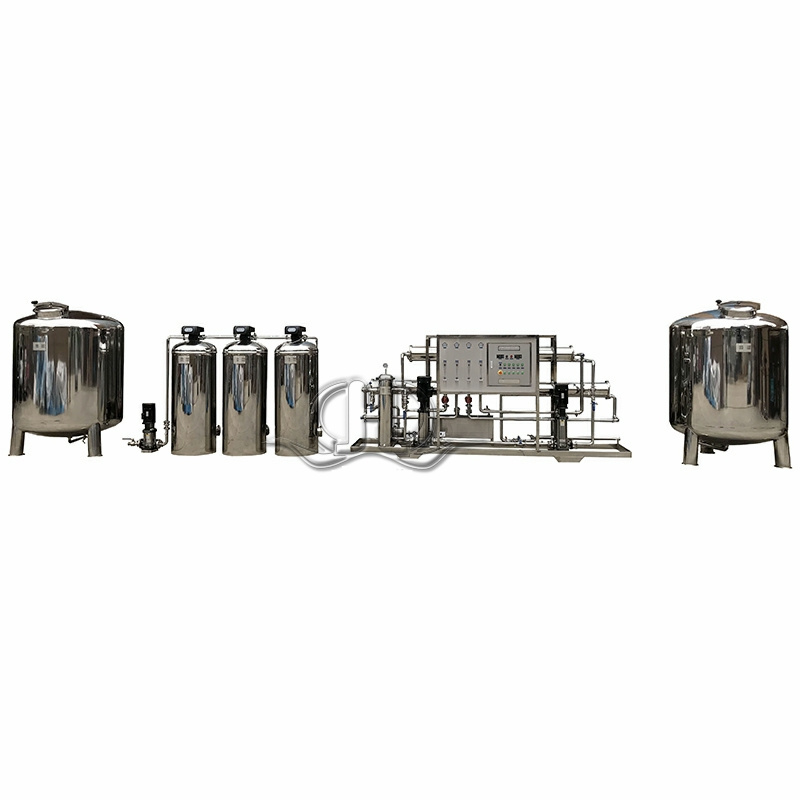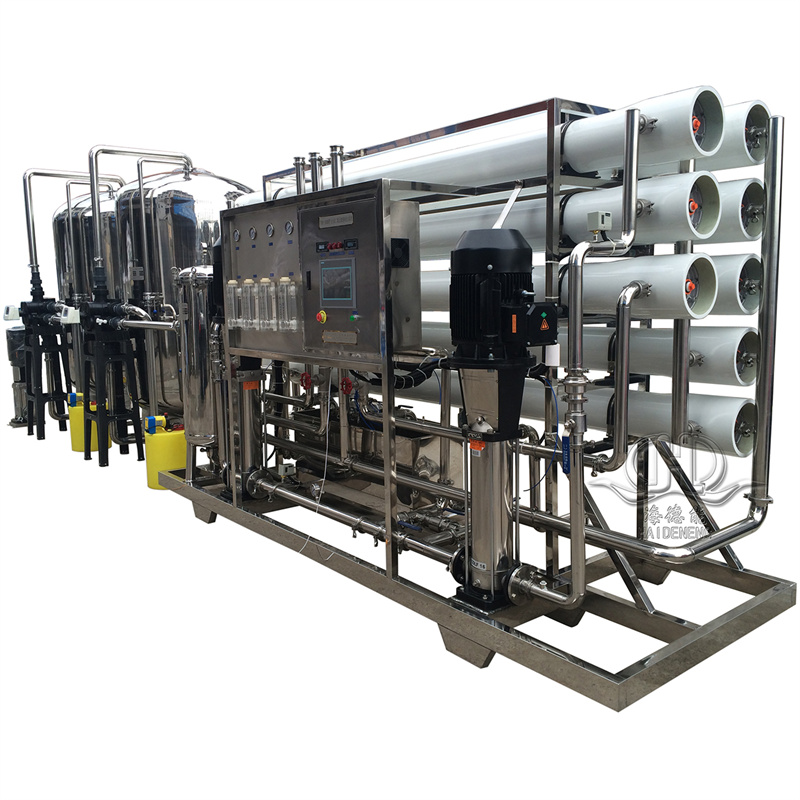Reverse osmosis precision filtration water treatment fully automatic filtration purification water system
Product description:
Technical analysis of fully automatic filtration and purification water system for reverse osmosis precision filtration water treatment
1、 System core architecture and process flow
The system is based on reverse osmosis (RO) membrane technology, combined with precision pretreatment and fully automatic control, to achieve deep purification of water quality from raw water to high-purity water. The core process is as follows:
plaintext
Raw water → pretreatment system (sand filter+carbon filter+fine filter) → fully automatic reverse osmosis device → post-treatment system → water production
System functions:
Pre treatment to remove suspended solids, organic matter, residual chlorine, and fine particles;
Deep desalination of reverse osmosis membrane, interception of dissolved salts and microorganisms;
Fully automatic control enables unmanned operation and intelligent maintenance.
2、 Key Unit Technical Principles and Parameters
1. Preprocessing system
Sand filter: Quartz sand (0.5-1.2mm) physically intercepts large particle impurities, reducing turbidity from 20NTU to ≤ 5NTU, backwashing intensity from 15-20L/(m ² · s), lasting for 5-10 minutes.
Carbon filter: Coconut shell activated carbon (specific surface area ≥ 1000m ²/g) adsorbs residual chlorine (removal rate>99%) and organic matter, with a contact time of 15 minutes, and residual chlorine in the effluent is ≤ 0.05mg/L.
Precision filter: 5 μ m PP melt blown filter element intercepts fine particles, ensuring inlet SDI ≤ 5 and protecting the RO membrane.
2. Fully automatic reverse osmosis device
Technical principle:
The high-pressure pump provides a pressure of 0.8-1.5MPa (brackish water) or 6-8MPa (seawater), and water molecules pass through the RO membrane (pore size 0.0001 μ m) with a salt retention rate of ≥ 99%.
Core parameters:
Membrane element: Polyamide composite membrane (such as Dow SW30HLLE), with a single water production capacity of 25m ³/day and a desalination rate of ≥ 99.5%;
Recovery rate: 60% -80%, water conductivity ≤ 50 μ S/cm (when the TDS of the raw water is less than 2000mg/L);
Automation: PLC controls low-pressure flushing (1 minute on), chemical flushing (5 minutes off), and automatic discharge of conductivity exceeding the standard.
3. Post processing system
PH adjustment: Add NaOH to adjust the pH of RO water from 5.5-6.0 to 7.0-8.0 to prevent pipeline corrosion;
Mineralization (optional): By filtering limestone or adding minerals, the taste can be improved (such as controlling the concentration of Ca ² ⁺ and Mg ² ⁺ within 10-20mg/L).
3、 Comparison of Water Quality Treatment Effects
Pre treated raw water (groundwater) and RO produced water during the treatment stage
Turbidity (NTU) ≤ 20 ≤ 1 ≤ 0.5
Residual chlorine (mg/L) ≤ 1.0 ≤ 0.05 ≤ 0.02
Total dissolved solids (TDS, mg/L) ≤ 1000 ≤ 800 ≤ 30
Conductivity (μ S/cm) ≤ 1500 ≤ 1200 ≤ 50
Total bacterial count (CFU/mL) ≤ 1000 ≤ 100 ≤ 1
4、 Technological advantages and innovative design
Fully automated intelligent control
Real time monitoring of pressure, flow rate, conductivity, and automatic adjustment of concentrated water discharge ratio;
Fault warning (such as membrane fouling alarm) and automatic flushing (triggered when the fouling index SDI>5) to reduce manual intervention.
Precision filtration and anti pollution technology
Third level pretreatment (sand filtration+carbon filtration+fine filtration) extends the RO membrane fouling cycle to more than 12 months;
The anti fouling coating on the membrane surface (such as hydrophilic modification) reduces the probability of organic matter adsorption and extends the cleaning cycle from the traditional 6 months to 18 months.
Energy saving and environmental optimization
The energy recovery device (PX pump) recovers concentrated water pressure, reducing energy consumption to 1.5-2kWh/m ³ (brackish water), which is 30% more energy-efficient than traditional systems;
Concentrated water reuse: When TDS<1000mg/L, it is reused for green irrigation, and the water resource utilization rate is increased to over 85%.
5、 Application scenarios
Deep purification of drinking water
Deep treatment of municipal tap water to remove heavy metals, nitrates, and pesticide residues, producing water that meets direct drinking standards (GB 5749-2022);
Community direct drinking water station, school/hospital centralized water supply system, equipped with ultraviolet sterilization.
Industrial high-purity water
Electronic semiconductor: chip cleaning water (conductivity ≤ 10 μ S/cm), requiring secondary RO+EDI production of ultrapure water (resistivity ≥ 18M Ω· cm);
Pharmaceutical industry: Preparation of water for injection (WFI) that meets GMP standards (endotoxin<0.25EU/mL).
Special water quality treatment
Seawater desalination: water supply for islands and ships (such as the Nansha Islands Seawater Desalination Station, with a water output of 500 tons/day);
Industrial wastewater reuse: Chemical high salt wastewater is treated by RO and reused for circulating cooling, achieving zero discharge through concentrated water evaporation and crystallization.
6、 Typical case: High purity water system in an industrial park
Raw water: groundwater (TDS 800mg/L, hardness 400mg/L);
System configuration:
plaintext
Raw water → sand filtration+carbon filtration → fine filtration (5 μ m) → first stage RO (1.2MPa) → second stage RO (0.8MPa) → EDI → ultra pure water tank
Running effect:
Water production: 50m ³/h, conductivity ≤ 0.1 μ S/cm;
Energy consumption: 2.8 kWh/m ³, cost 4-6 yuan/ton;
System recovery rate: Secondary RO reaches 90%, and concentrated water is reused for park greening.
7、 Maintenance and troubleshooting
Analysis of common problem causes and solutions
RO water production decreases due to membrane fouling/low inlet water temperature, citric acid cleaning (pH=2.5)/heating up to 25 ℃
Leakage of membrane components with conductivity exceeding the standard/high reflux ratio of concentrated water detection membrane shell sealing ring/reducing reflux ratio to 30%
Filter element blockage due to sudden increase in pre-treatment pressure difference/sudden increase in raw water turbidity Replace fine filter element/Increase pre-treatment backwash
8、 Technological development trends
Low pressure and high desalination membrane: Develop ultra-thin composite membranes (desalination layer<300nm) to reduce operating pressure to below 0.5MPa;
Intelligent operation and maintenance: integrating AI algorithms to predict membrane fouling, automatically adjusting operating parameters (such as pressure and recovery rate), and optimizing energy consumption;
Modular design: Standardized containerized equipment (such as a 20 foot container with a water production capacity of 100m ³/day) for quick deployment (such as emergency water supply).
This system plays a key role in the fields of drinking water safety, industrial high-purity water, and wastewater resource utilization through the deep combination of reverse osmosis and precision filtration. With the advancement of membrane technology and intelligence, its application will be expanded to a wider range of scenarios.






